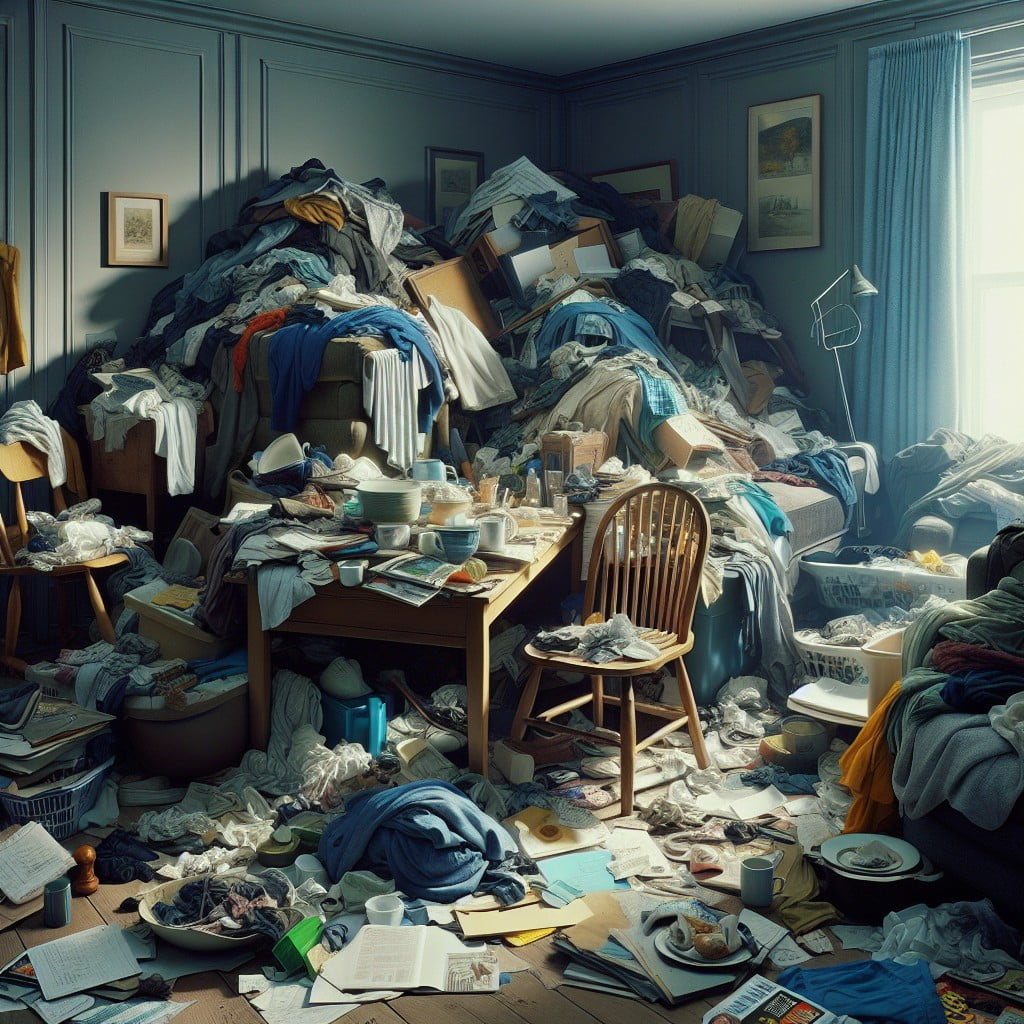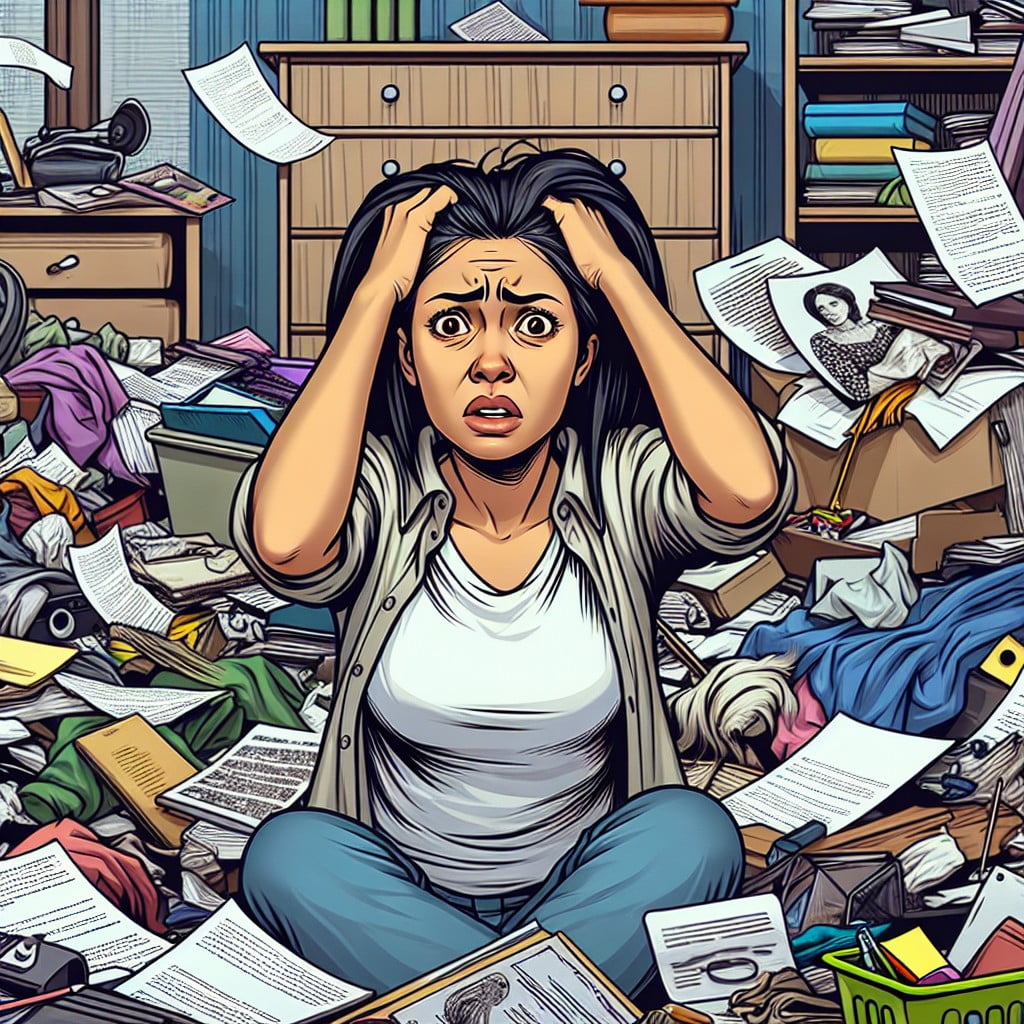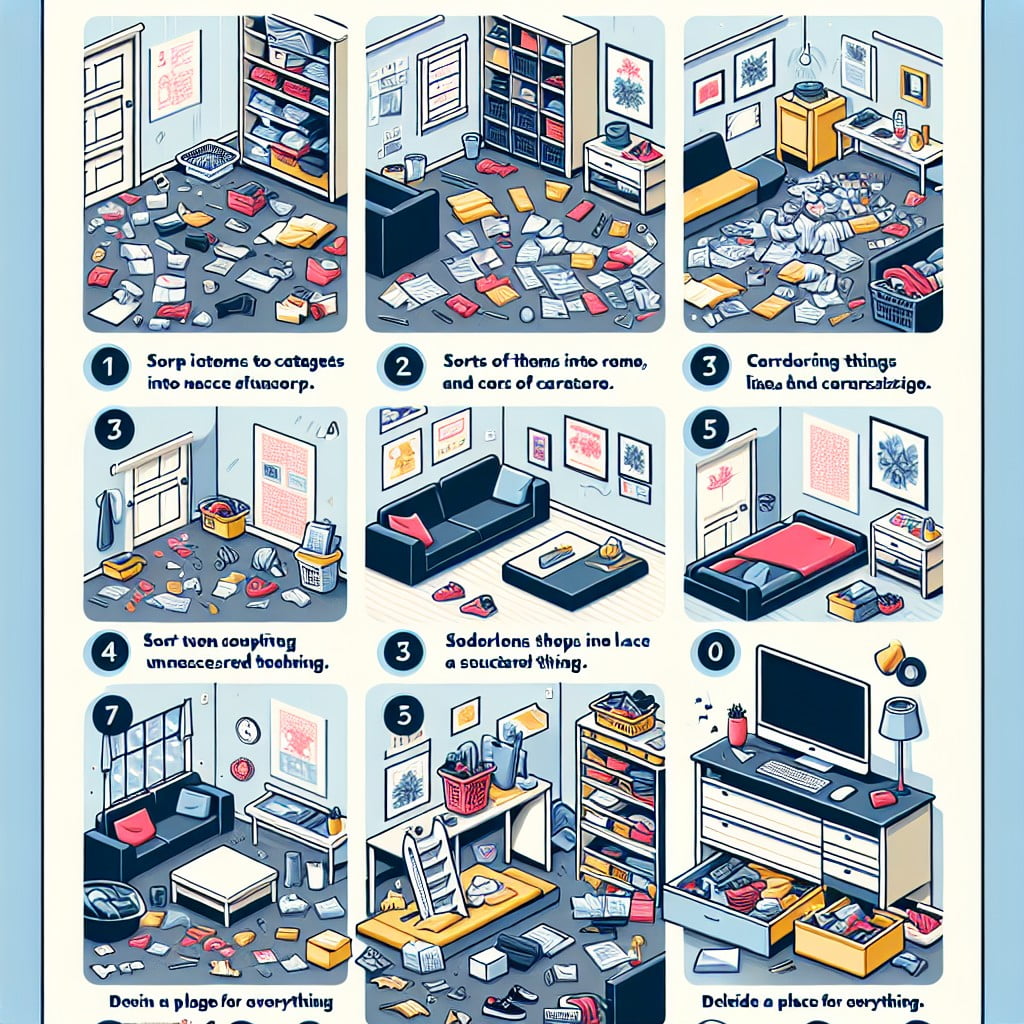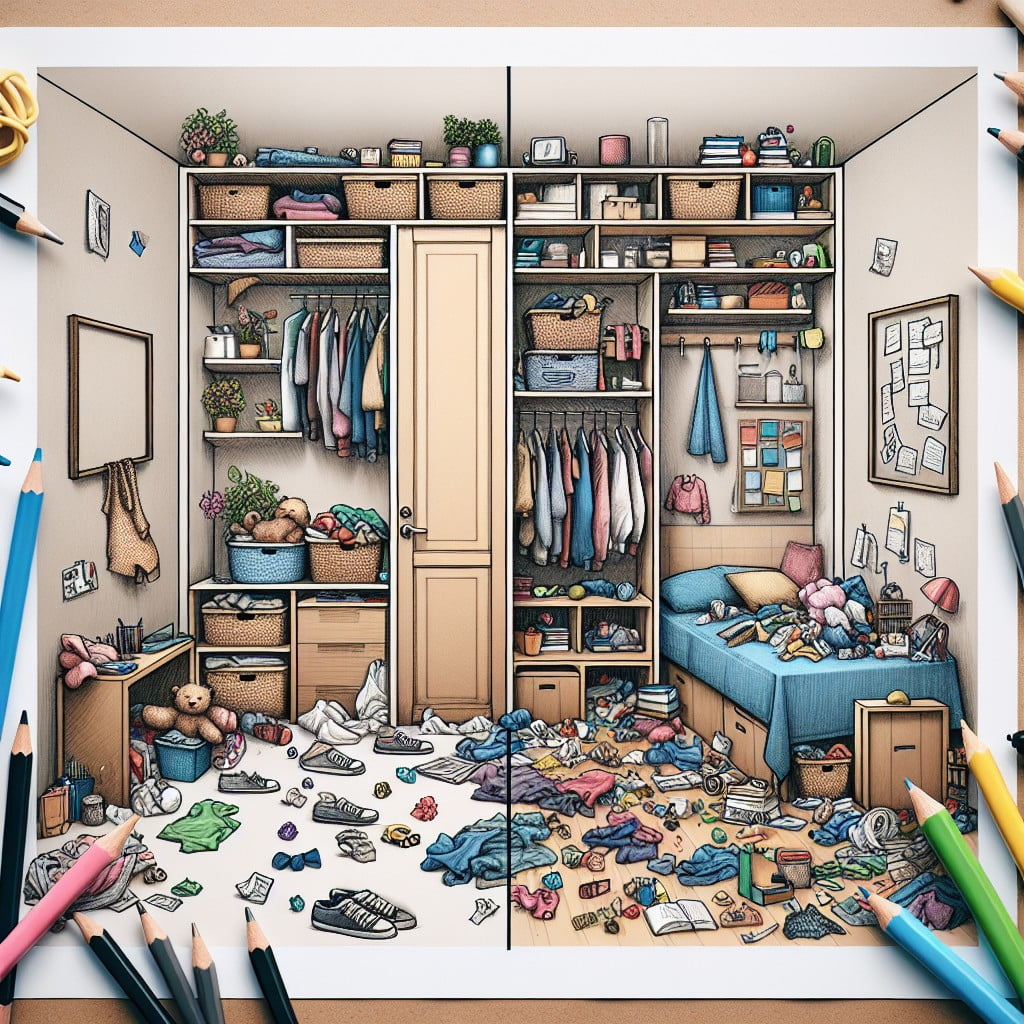Last updated on
Dive into this enlightening piece because decluttering your room not only transforms your space but also improves your mental well-being.
Key takeaways:
- A cluttered room can increase stress and anxiety levels.
- Clutter impairs focus and reduces productivity.
- Decluttering improves sleep quality and mental well-being.
- The “4-Box Technique” helps in sorting and eliminating excess items.
- Utilizing vertical storage and implementing daily decluttering habits are key to maintaining a clutter-free space.
Impact of Clutter On Mental Health

A chaotic environment often leads to a chaotic mind. Excessive items in one’s surroundings can elevate stress levels, making it difficult to relax, both physically and mentally. The visual disarray signals to the brain that there’s an unfinished task, contributing to feelings of anxiety and overwhelm.
This sense of disorder can also impede focus. With multiple visual stimuli competing for attention, the brain’s cognitive function may decrease, making it tougher to concentrate on daily tasks or to make decisions effectively. Attention is fragmented, and productivity may take a hit as a result.
Moreover, personal relationships can feel the strain of a cluttered space. Tensions may rise when living areas do not offer a serene retreat for family members or roommates, potentially leading to more frequent conflicts. The comfort that a home typically provides gets lost amidst the clutter.
Living in cluttered spaces can also affect sleep quality. As the mind processes the visual cues of disarray, it can be harder to unwind and quiet the mind for a restful night, making sleep less rejuvenating and contributing to a cycle of stress and fatigue.
Psychological Implications of a Cluttered Room

A cluttered room has been linked to various psychological effects that can impact daily life. Research suggests that excessive clutter can lead to increased stress, feelings of anxiety, and difficulty focusing.
Here are some key points that highlight the psychological effects of living in a cluttered space:
- Stress Hormone Production: Piles of clutter can trigger the release of cortisol, the body’s primary stress hormone, which can contribute to feelings of overwhelm and fatigue.
- Increased Anxiety: The sight of clutter can create a sensory overload, sending signals to the brain that work is never done. This can heighten anxiety levels, particularly for individuals prone to anxious thoughts.
- Reduced Focus and Productivity: Clutter competes for your attention, drawing it away from tasks that require concentration and thereby reducing overall productivity.
- Impaired Decision-Making: An untidy room can lead to information processing difficulties, meaning decision-making becomes more challenging, as the brain is cluttered with unnecessary stimuli.
- Sleep Disturbance: A disorderly bedroom can interfere with the ability to relax and fall asleep, potentially contributing to sleep deprivation and its associated health issues.
- Attachment to Possessions: Clutter might reflect a deeper psychological attachment to material items, making it hard to let go and contributing to a cycle of accumulation.
By understanding these mental health implications, it becomes clear that decluttering is not just a physical activity but also an investment in one’s mental well-being.
Step-by-Step Guide to Organizing a Cluttered Room

Begin by setting a clear objective for the room’s function, which will guide your organization efforts. With the purpose in mind, tackle the clutter with these strategic steps:
1. Sort and Categorize: Take everything out of the space. Create separate piles or use boxes to categorize items, labeling them as ‘keep’, ‘discard’, ‘donate/sell’, and ‘store elsewhere’.
2. Clean the Area: With all items removed, thoroughly clean the room. This provides a fresh canvas for reorganizing the space and may increase motivation to keep it tidy.
3. Prioritize Items: Focus on the ‘keep’ pile. Consider the frequency and importance of each item. Items used daily should be easily accessible, while rarely used items can be stored away.
4. Opt for Clever Storage: Invest in storage solutions that fit your space and the categorized items. Shelves, bins, hooks, and under-bed containers can be functional choices.
5. Set Boundaries: Limit the number of items per category (books, clothes, etc.) to prevent future clutter. Each item should have its designated place.
6. Revisit Regularly: Schedule periodic reviews of room contents to re-evaluate their necessity, ideally every few months, to maintain organization and prevent clutter from build-up.
Strategic Decluttering: Tactics and Starting Points

Embarking on the journey of decluttering can often feel overwhelming. To tackle this challenge effectively, begin by zoning your space. Divide the room into manageable sections, whether it’s by furniture pieces or by areas such as the closet, desk, or shelves. This approach allows for a focused effort, preventing burnout and providing a sense of accomplishment as each zone is completed.
Next, prioritize the zones based on either their level of clutter or the ease of clearing them. Starting with the easiest section can generate momentum, while tackling the most cluttered area first can have a dramatic impact and motivate you to continue.
Consider the five-minute rule for instant gratification: if a task can be completed in five minutes or less, do it immediately. This could include discarding trash, returning items to their designated spots, or filing papers. These quick wins contribute to a visible difference in your space without a significant time investment.
Set realistic goals for each decluttering session to make the task less daunting. Instead of aiming to organize an entire room in one go, focus on one zone at a time, perhaps dedicating 30 minutes daily, to steadily transform your cluttered room. Remember, consistency is key to maintaining progress in strategic decluttering efforts.
Efficient Sorting and Eliminating Excess
Begin the sorting process by setting aside a block of time dedicated solely to organizing. Group items into categories such as clothing, books, or paperwork. This categorical approach streamlines decision-making and helps you to see the volume of possessions within each type.
Once categorized, assess each item for its necessity, emotional value, and frequency of use. Ask yourself if it’s been used in the past year or if it contributes positively to your daily life. If not, it might be time to say goodbye.
For the elimination phase, implement the “one in, one out” rule to prevent future accumulation. When you acquire a new item, choose a similar item to donate or recycle, keeping your belongings within a manageable count.
Consider challenging yourself with the “12-12-12” approach: find 12 items to throw away, 12 to donate, and 12 to be returned to their proper location. It’s a simple yet effective technique for maintaining order and creating space.
Think creatively about repurposing items you no longer need for their original intent. A jar can become a container for stationery, and old clothes might be transformed into cleaning rags.
When faced with sentimental items, create a memory box for the treasures that genuinely matter, but limit its size to encourage discernment. Digital photographs of items can also preserve memories without occupying physical space.
Lastly, adopt a minimalist mindset, focusing on quality over quantity. Opt for items that serve multiple purposes and align with your lifestyle, ensuring that each object in your space is there for a reason.
Ideal Storage Solutions for Various Items
Maximize space with multi-functional furniture, such as ottomans featuring hidden compartments or beds with built-in drawers underneath, providing discreet storage for blankets and seasonal clothing.
Employ vertical shelving units to take advantage of unused wall space, ideal for books, decorative items, and organized boxes containing smaller objects like craft supplies or electronics.
Incorporate clear, stackable storage bins in closets or under beds, allowing for easy identification of contents without the need to unpack and providing a neat way to store shoes, out-of-season garments, or holiday decorations.
Insert drawer dividers in dressers and kitchen drawers to compartmentalize items such as utensils, accessories, or office supplies, ensuring everything has a designated place and is accessible when needed.
Adopt the use of over-the-door organizers in bedrooms, bathrooms, and laundry rooms to store items like shoes, toiletries, or cleaning products, effectively freeing up floor and shelf space.
Opt for hanging racks or pegboards in craft rooms or garages to neatly display tools, art supplies, or sports equipment, simultaneously making them accessible and showcasing personal hobbies and interests.
Maintaining a Decluttered Room
To preserve the serenity of a streamlined space, adopt daily habits that prevent the return of clutter. Start with a ‘one in, one out’ rule; for every new item introduced into a room, find one to discard or donate. This ensures a constant balance and inhibits excess.
Implement a five-minute nightly routine dedicated to straightening up. Store remotes, fold throws, and return books to shelves. These small actions can drastically reduce the potential for clutter accumulation.
Utilize designated baskets or bins for items that tend to scatter, such as toys or magazines. Establish a weekly review to clear out anything that doesn’t belong.
Regularly evaluate your possessions. As your interests and needs evolve, so should your belongings. Quarterly purges aligned with seasonal changes can keep your space current and clutter-free.
Last**l**y, encourage household members to engage in these practices. Shared commitment makes maintenance easier and extends the clutter-free benefits to everyone in the home.
Coping With Limited Space
Maximizing small quarters requires creativity and a shift in perspective. Consider a multi-functional approach where furniture serves double duty, such as a bed with built-in drawers or a desk that folds away when not in use.
Embrace the vertical space by installing shelves up high to keep floors clear and expand storage opportunities. Use hooks on walls or over-the-door organizers to keep everyday items accessible but orderly.
Opt for light-colored or mirrored furnishings that can make the area feel more open and less constricted. Finally, be rigorous about what you bring into your space. Each item should have a purpose or bring joy; otherwise, it’s just occupying valuable real estate.
Finding Time to Declutter a Busy Schedule
Scheduling regular, brief decluttering sessions can seamlessly integrate this task into a hectic day. Consider the following points:
- Prioritize Decluttering: Treat it like any other important appointment by blocking out a specific time in your calendar.
- Start Small: Even 15 minutes a day can make a significant difference—focus on one shelf or drawer to prevent feeling overwhelmed.
- Use Waiting Time Wisely: Declutter during periods of downtime, such as while waiting for dinner to cook or during TV commercial breaks.
- Make It a Family Affair: Involve household members in decluttering tasks, which can speed up the process and foster a sense of shared responsibility.
- Declutter Digitally: Use time spent on your phone or computer to organize digital files — it’s still decluttering.
- Routine Incorporation: Weave decluttering into your daily routine, perhaps by picking up five items every morning to put away or discard.
Remember, consistent, small efforts will accumulate to significant results over time.
Utilizing Vertical Storage and Wall Decor
Maximizing your room’s vertical space can transform a cluttered area into a functional and aesthetically pleasing environment. Consider installing floating shelves to keep books, plants, and personal items off the floor and at eye level. Wall-mounted racks and hooks offer a home for jewelry, hats, or keys and keep them readily accessible. For those frequently used items that seem always to clutter surfaces, hanging organizers can be a godsend. Moreover, utilizing the back of the door with over-the-door storage racks or pockets can provide extra areas to stow away belongings. Incorporating decorative wall boxes or mesh panels can also add a touch of style while serving a practical purpose. Remember, your walls aren’t just for paintings or photos; they’re valuable real estate for clever storage solutions.
Addressing the Root of Clutter Problems
Unearthing the underlying causes of accumulation helps tackle clutter more effectively. Often, emotional attachments to objects or the “just in case” mindset leads to unnecessary hoarding. Understanding that holding onto items doesn’t equate to preserving memories can be liberating.
Procrastination is another common clutter culprit. Adopt a “do it now” philosophy for managing mail, laundry, and other daily tasks to prevent pile-ups. Purchasing with intention rather than on impulse can also stem the tide of clutter. Before adding a new item to your space, consider its necessity and the available room to accommodate it.
Finally, assess your organizational systems. Inadequate storage or unclear categorization can make maintaining a tidy space challenging. Streamlining these systems and ensuring everything has a designated place can significantly reduce the likelihood of disorder reemerging.
Tackling Clutter With the 4-Box Technique
Embarking on the 4-Box Technique can transform your cluttered space into an organized haven. Begin by setting up four distinct containers and allocating each one for ‘Keep’, ‘Donate/Sell’, ‘Store’, and ‘Trash’. As you sift through items, decide which box they belong in based on immediate usefulness, emotional attachment, condition, and value.
Keep: This box is for items you use regularly and that truly serve a purpose in your daily life. Be judicious to prevent simply moving clutter around.
Donate/Sell: Place items of value that you no longer need or want here. They can benefit someone else, and you can possibly earn some cash or a tax deduction.
Store: Seasonal decorations, keepsakes, and infrequently used items belong here. Ensure you have the space to store these items neatly.
Trash: Broken, worn out, or otherwise unusable items should be thrown away. Be honest to avoid hoarding broken objects.
This approach encourages quick decision-making and helps in breaking down a potentially overwhelming task into manageable chunks. Remember, revisiting each box after the initial sort can further refine your space to perfection.
Where to Dispose of or Donate Unwanted Items
Once you’ve decided which items to let go, the next step is finding them a new home where they can be useful. Here are a few options:
- Charity Shops: Clothing, books, and household goods often find new life through charity shops. Supporting a cause, you care about with your donations can make the decluttering process more rewarding.
- Recycling Centers: For items that can’t be donated, such as broken electronics or worn-out textiles, check local recycling options to dispose of them responsibly.
- Online Marketplaces: Valuable or lightly used items might find eager buyers through online platforms. Selling them can supplement your budget.
- Giveaway Sites: Websites and apps dedicated to free exchanges in your community are great for items you wish to quickly pass on to neighbors.
- Specialty Services: Some organizations specialize in collecting certain items, like old eyeglasses or mobile phones, for refurbishment and redistribution.
- Local Shelters: Everyday necessities are always in demand at shelters — consider donating items that can directly help those in need.
Research the specific organizations and regulations in your area to ensure your unwanted items are disposed of correctly, supporting your community and the environment in the process.
Identifying Why a House Feels Cluttered
A cluttered house often doesn’t stem from merely owning too many items; it can be a manifestation of underlying issues. Distinguishing these root causes is essential in creating a lasting organized space.
- Sentimental Attachment: Holding onto items due to emotional significance can lead to unnecessary clutter, as objects that are rarely used take up valuable space.
- Overestimation of Need: The belief that something might be useful in the future causes accumulation of goods that never actually serve their intended purpose.
- Lack of Organizational Systems: Without a designated place for each item, belongings end up scattered or stacked in piles, contributing to a disorderly environment.
- Haphazard Shopping Habits: Impulsive or unthoughtful purchases can lead to an influx of items that don’t have a practical place in the home.
- Inefficient Use of Space: Furniture that’s too large or improperly arranged can make a room feel cluttered; likewise, not utilizing hidden storage areas makes a living space appear disorganized.
Addressing these patterns can make the decluttering process not only about discarding items but also about implementing better habits and systems to prevent future clutter.
Transitioning From a Cluttered Home to a Haven
Embarking on the journey from disarray to tranquility involves a shift in both mindset and environment. Consider these points as you transform your space:
1. Define your vision of a haven: Determine what a peaceful and restorative home looks like to you. It could be minimalist, cozy, or inspired by nature – tailor it to your personal sense of calm.
2. Curate with intention: Keep items that serve a purpose or bring joy. Dispose of the rest thoughtfully, whether through donation, recycling, or selling.
3. Implement calming colors and textures: Utilize hues and materials that promote relaxation, such as soft blues, greens, and natural fibers.
4. Invest in quality over quantity: Choose fewer, better-quality possessions that will last longer and make your space feel less cluttered.
5. Arrange with accessibility in mind: Place frequently used items within easy reach and store seasonal or rarely used items out of the way.
6. Embrace open spaces: Resist the urge to fill every nook; open areas can be both visually pleasing and calming.
7. Incorporate nature: Introduce plants, natural light, or a water feature to bring a sense of outdoor serenity inside.
8. Foster soothing habits: Make your haven a place for practices that promote wellness, like meditation, reading, or listening to calming music.
By applying these points, your home can evolve into a personalized sanctuary, promoting a clearer mind and a more relaxed lifestyle.
FAQ
What does a cluttered room mean?
A cluttered room, psychologically speaking, often signifies a disorganized mind and can be an indicator of underlying mental health issues such as depression, while further exacerbating stress and anxiety levels.
What makes a bedroom look cluttered?
A bedroom looks cluttered when clothing, shoes, books and other items are strewn on the floor instead of being properly placed in designated locations.
What is the 12 12 12 rule for decluttering?
The 12 12 12 rule for decluttering is a method where you identify 12 items to discard, 12 items to donate, and 12 items to return to their appropriate positions in your home.
How does a cluttered room impact mental health?
A cluttered room can negatively impact mental health by increasing stress levels, reducing focus, and contributing to feelings of anxiety and depression.
What are the benefits of decluttering a room?
Decluttering a room can enhance productivity, reduce stress, promote better sleep, and improve focus by maintaining a clean and organized environment.
What are some efficient strategies for maintaining a clutter-free room?
Efficient strategies for maintaining a clutter-free room include regular decluttering, use of appropriate storage solutions, minimalism, maintaining a daily cleaning routine, and categorizing belongings.
Recap:




